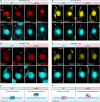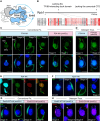A specialized TFIIB is required for transcription of transposon-targeting noncoding RNAs
- PMID: 40377217
- PMCID: PMC12082453
- DOI: 10.1093/nar/gkaf427
A specialized TFIIB is required for transcription of transposon-targeting noncoding RNAs
Abstract
Transposable elements (TEs) pose threats to genome stability. Therefore, small RNA-mediated heterochromatinization suppresses the transcription and hence the mobility of TEs. Paradoxically, transcription of noncoding RNA (ncRNA) from TEs is needed for the production of TE-targeting small RNAs and/or recruiting the silencing machinery to TEs. Hence, specialized RNA polymerase II (Pol II) regulators are required for such unconventional transcription in different organisms, including the developmental stage-specific Mediator complex (Med)-associated proteins in the ncRNA transcription from TE-related sequences in Tetrahymena. Yet it remains unclear how the Pol II transcriptional machinery is assembled at TE-related sequences for the ncRNA transcription. Here, we report that Pol II is regulated by Emit3, a stage-specific TFIIB-like protein specialized in TE transcription. Emit3 interacts with the TFIIH complex and localizes to TE-dense regions, especially at sites enriched with a G-rich sequence motif. Deletion of Emit3 globally abolishes Pol II-chromatin association in the meiotic nucleus, disrupts the chromatin binding of Med, and impairs the TE-biased localization of TFIIH. Conversely, Emit3's preferential localization to TE-rich loci relies in part on Med-associated proteins. These findings suggest that Emit3, TFIIH, and Med-associated proteins work together to initiate Pol II ncRNA transcription from TE-dense regions, possibly in a sequence-dependent manner.
© The Author(s) 2025. Published by Oxford University Press on behalf of Nucleic Acids Research.
Conflict of interest statement
The authors declare no competing interests.
Figures







Similar articles
-
Non-coding RNA Transcription in Tetrahymena Meiotic Nuclei Requires Dedicated Mediator Complex-Associated Proteins.Curr Biol. 2019 Jul 22;29(14):2359-2370.e5. doi: 10.1016/j.cub.2019.05.038. Epub 2019 Jul 4. Curr Biol. 2019. PMID: 31280995
-
The role of Mediator in small and long noncoding RNA production in Arabidopsis thaliana.EMBO J. 2011 Mar 2;30(5):814-22. doi: 10.1038/emboj.2011.3. Epub 2011 Jan 21. EMBO J. 2011. PMID: 21252857 Free PMC article.
-
The Med31 Conserved Component of the Divergent Mediator Complex in Tetrahymena thermophila Participates in Developmental Regulation.Curr Biol. 2019 Jul 22;29(14):2371-2379.e6. doi: 10.1016/j.cub.2019.06.052. Epub 2019 Jul 4. Curr Biol. 2019. PMID: 31280994
-
Noncoding RNAs: Regulators of the Mammalian Transcription Machinery.J Mol Biol. 2016 Jun 19;428(12):2652-2659. doi: 10.1016/j.jmb.2016.02.019. Epub 2016 Feb 23. J Mol Biol. 2016. PMID: 26920110 Free PMC article. Review.
-
The Mediator complex and transcription regulation.Crit Rev Biochem Mol Biol. 2013 Nov-Dec;48(6):575-608. doi: 10.3109/10409238.2013.840259. Epub 2013 Oct 3. Crit Rev Biochem Mol Biol. 2013. PMID: 24088064 Free PMC article. Review.
References
MeSH terms
Substances
Grants and funding
LinkOut - more resources
Full Text Sources
Research Materials

